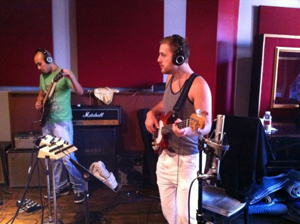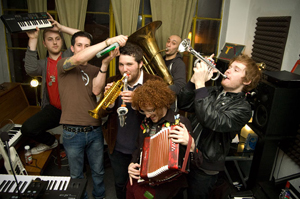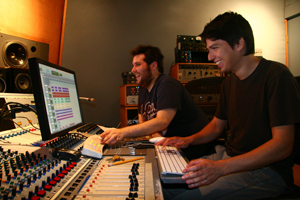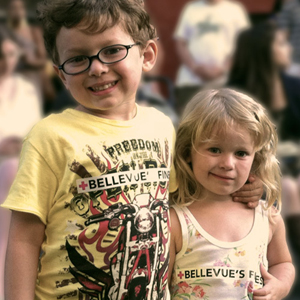Band-Made: Bellevue’s Finest Self-Produce Eponymous EP
Kips Bay, Manhattan: NYC indie synth-pop band Bellevue’s Finest self-produced their latest, eponymous EP in a variety of environments on a range of gear — bouncing between Mboxes and Neve consoles, laptop Logic systems and full-blown Pro Tools HD rigs. The modern indie band’s secret weapon is its production savvy and Bellevue’s Finest has a built-in producer/engineer in singer Frans Mernick.
A recent graduate of the selective Sonic Arts Center at the City College of New York, Mernick produces the band’s catchy pop songs in gritty electro-punk style — combining digitized analog synths and programmed bits with live band performances captured in rehearsal and recording studios around the city. Recording and production concepts are intrinsic to this band of self-proclaimed “gear heads,” who cite 70s era David Bowie and modern electro-pop a la Passion Pit and Hot Chip as influences.
The new EP, out today, began on Mernick’s laptop and grew in layers as the band — including guitarist David Fell, synth/keyboardist David Haken, synth/keyboardist Adam Sontag, bass player David Glickstein and drummer Keenan Mcrae — got together in the studio.
Named for the Kips Bay neighborhood where these guys came up, in the shadow of Bellevue Hospital, Bellevue’s Finest is in its finest form on the new EP — a four-track serving of energizing indie-pop of the cool, danceable post-punk variety. Here, we talk to the band about their evolving sound and the methods applied on this latest release, Bellevue’s Finest (downloadable here):
Bellevue’s Finest released its first EP, 10010, in early ’09. Tell us about your earliest sound and how that’s progressed to your new EP, Bellevue’s Finest?
Frans: A lot of the inspiration for the first EP, 10010, came from my fooling around with Pro Tools for the first time years ago. In fact, our growing knowledge of audio technology has directly influenced our direction as a band.
Our first EP had a very lo-fi, distorted feel. It was a concoction of influences, incorporating chaotic distorted drum samples, heavy guitars and robust vocals. I remember a good friend once said, “If Spencer Krug, Frank Black, and Julian Casablancas put their seed into Kylie Minogue – your EP would spill forth from her womb.” I never quite understood that, but I love it.
Since this first EP, we’ve gotten a bit less punk and a bit more indie-pop. Our sound is much more spontaneous and live on this new record. I made a point of capturing live performances this time around, whereas on our last EP, we never had any two people playing simultaneously.
And tell us a bit about your songwriting and production process — how does a Bellevue’s Finest tune come together?
Frans: Sometimes a song starts out with our guitarist (David Fell) working out the progression on his guitar and singing along some lyrics, but recently most of the time, the songs have started on my laptop in Logic. I have been compiling an extensive collection of analog synth sampler instruments in Logic’s EXS-24. I basically take vintage analogue keyboards, find a sound I like, record every note of that sound, and import it into a digital sampler.
Using these sounds, I start piecing together songs on my laptop. When I bring these songs to the band, everyone generates their own parts, and we work together on the arrangement.
David Glickstein: Once we’re in the studio, we have a good idea of most of the parts that need to be laid down, though there are always spontaneous overdubbed rhythm and synth parts, and last-minute guitar lines. But before we actually record, we like to mess around with the different equipment that the studio has to offer. This is where our music gets some legs. Flux Studios, the studio where we recorded the majority of our EP, has a bevy of analog synths, tube amps, tape delays, and all sorts of other goodies that appeal to gearheads like us.
Flux is top-notch! Tell us a bit about the recording process and equipment setup in the studio?
Frans: The process of making this record was definitely a modern one in the sense that we recorded and wrote anywhere at anytime, wherever we could. We started by tracking drums and bass live up at City College’s Sonic Arts Center in Harlem. They have a nice setup there with smooth-running HD rigs.
The general mic setup was fairly standard — AKG D112 inside the kick, the outside mic changed from session to session, Sennheiser 421’s on the toms, Shure SM57 on snare top and bottom, stereo matched AKG C-414’s as overheards and some Royer 122 ribbons as room mics. Aside from the room mics, most of the microphones were heading straight to API 3124 preamps. The 3124’s sound fantastically clear, but maintain some nice API character, and they are my go-to preamp in a lot of situations.
I ran the room mics into Pacifica pre-amps, which then ran through a pair of stereo Distressors, where I would adequately crush them before Pro Tools. I like compressing my room mics on the way in — it assigns a specific vibe to the drums I’m recording. With Bass, I usually took a DI signal straight into an API preamp, and then also had a 421 on a vintage Ampeg flip-top, heading into a Universal Audio 6176 pre/compressor joined. I would never compress the bass too drastically during tracking, just enough to get some character out of the outboard.
After we finished tracking the drums and bass, I would usually mix them until they were suitable reference tracks for recording, and bounce them. I would then bring my laptop to our practice space, where I would connect an M-Audio MIDI controller, and have Adam control some of my analog synth samples. It was liberating: We were able to use MIDI within Logic to control sounds of such classic synths as Moog Opus, Korg Delta, MiniMoog, Korg Poly-800, Moog Prodigy, Korg MiniKorg…the list goes on for days.

In Flux: David Fell (Guitar) and David Glickstein (bass) of Bellevue's Finest recording at Flux Studios.
After that, I’d import these new synth tracks into the session, and head downtown to Flux, which in addition to a Neve console, extensive outboard gear and a nice tracking room, has the best collection of guitar amps I’ve seen in New York City.
We always gravitated towards one: a Vox AC-30 from the early 1970’s. It had that perfect, subtle grit that we were looking for on this record. I would throw a 57 and Neumann U 47 in front of it, David would plug in his guitar, and everything just sounded like butter.
I ran both of these microphones into a stereo set of Mercury pre-amps that they have in Flux. They have output attenuation, allowing me to add some grit from the pre itself, which always gets a warm, classic tone, without having to hit tape.
From an audio engineering perspective, what do you think was most challenging/ compelling about this project?
Frans: The most challenging part of the project was definitely in the mixing stages, because we recorded these tracks using so many different systems, spaces and gear. It definitely was a challenge to make the songs sound like they were coming from a single place. In the end using a variety of plug-ins, as well as the help and guidance of amazing mixer and mentor Fab Dupont, we were able to make the mixes sound natural.
Did you guys master the record yourselves as well?
David Fell: When it came time for mastering, we went straight to The Lodge without any second thought. Joe LaPorta is a great engineer and down-to-earth guy — he was willing to sit with me for as long as it took to go through endless, subtly different options until we got exactly what we were going for. His trustworthy ears and outsider’s perspective were invaluable.
After working on a track for as many hours as we did each of these, you start to doubt what you’re hearing and what you want to hear, and Joe always reassured us at the end of the process, with honest feedback.
What was your sonic objective, or objectives, and give us a couple examples of how you achieved those sounds.
Frans: We wanted to keep a vintage, organic feel, while using modern recording techniques. When recording with Pro Tools, it’s tough to get everything to sound like it’s in one place. I very much relied on subgroup compression. For example, I would take the drums and the bass, and compress them together; for the synths and the guitars I would do the same. This helped the tracks mesh much better than they would have otherwise.
Also, a little bit of synthetic reverb can go a long way with synths, especially ones that were recorded direct.
What’s a highlight track for you on the record, one that — in particular — you feel really captures the sound, energy and/or experience you wanted to produce?
Adam: Our newest single, “Wannabe,” is a song that manages to capture where we’ve come from and where we’re going as a band. While its mellow, wandering synths bring a layer of electro sheen, they’re happy to cede to thumping, anthemic rock n’ roll. But then, the driving bass and the shouting dudes relent, creating, as Frans sings in the second verse, a “world of dichotomy.” All the while, the drums are never quite willing to let you stop shaking your ass. It’s like a pop song, only with a dense, creamy center. Plus, anything we can do to associate ourselves with the Spice Girls is probably a net positive for us.
Listen to “Wannabe” here:
Listen to “Wannabe” here
Who’s another artist/producer you can name that you see doing great work in the studio, and in what ways does that influence or inspire you?
Kevin Barnes has been a big inspiration for us in terms of combining intellectual songwriting with outrageous catchiness. He has a unique ability to weave unconventional chord changes and melodies into a familiar, yet evolving aesthetic. The charts are infested with epic synth-pop tracks created by guys like Dr. Luke, and we also aspire to emulate their sonic swagger. (And success.)
What’s your band’s plan with this EP – how will you promote yourselves? What are your hopes and dreams for the next year?
We have an awesome, animated video for “Wannabe” that’ll be released with the EP. We’re already back in the studio, at the beginning stages of a new record. Most likely, we’ll take a similar approach to what we did this time around, where we release a series of singles followed by a full EP come next Spring.
This is our self-titled EP, so we want to get as much Bellevue’s Finest to the people as possible. We plan on attacking the college scene, on the ground and through the airwaves. They will acquiesce! It’s 2010, so we do all that social media jazz. Not because we think we’re cool or anything, but just because it’s the only way to do it these days on the cheap. We’re reserving our band fund for a blockbuster ad at Super Bowl XLV.
Check out Bellevue’s Finest and download their new EP at http://www.bellevuesfinest.com. Catch their EP release show tonight at Cake Shop.
Please note: When you buy products through links on this page, we may earn an affiliate commission.









